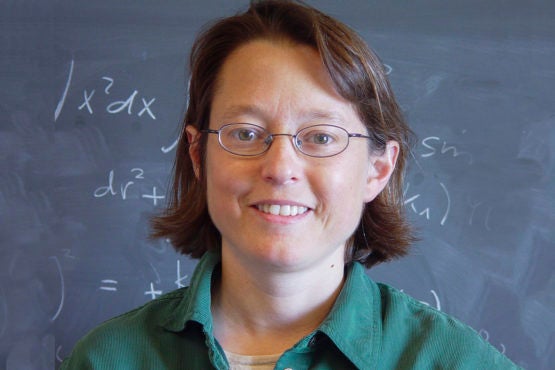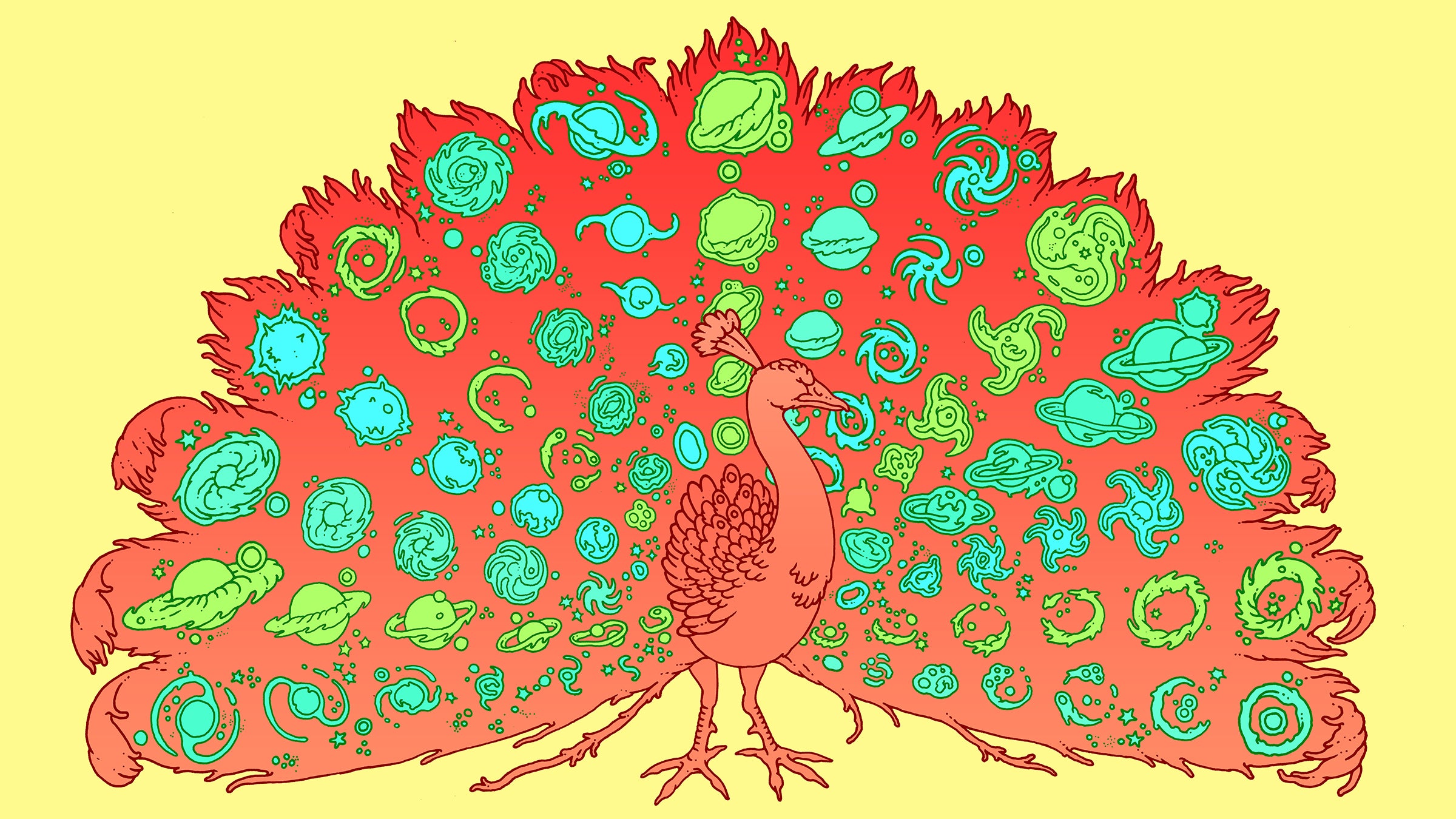Lambda leads the way
The discovery of dark energy in the 1990s marked a time of reckoning for string theorists: Either their theory had to account for the newfound force that was pushing space-time apart or they had to admit that string theory may never describe the universe we actually live in. This story is part 4 of a five-part series.
In 1998, astronomers hunting halfway across the universe for the ebbing light of exploded stars announced they had discovered evidence that the universe’s expansion is speeding up and not, as had been suspected since 1929, slowing down.
The realization came as “a thunderbolt to physicists, something so shocking that we are still reeling from the impact,” Leonard Susskind wrote in his book The Cosmic Landscape.
“Physicists everywhere were asking, ‘Is the experiment wrong?’” Renata Kallosh recalled.
But with every passing year, new experiments confirmed the results: Expansion is accelerating, not slowing down. For those results to be true, an elusive force that physicists had come to refer to as “dark energy” must be real. Einstein had predicted the existence of dark energy in 1917 when he applied his general theory of relativity to the structure of space-time. He needed a hypothetical force to prevent the universe from collapsing, so he invented a repulsive, space-filling energy that he called the cosmological constant, or lambda. When astronomers discovered in the 1920s that the universe is expanding, Einstein realized that lambda was no longer necessary and he scrapped the idea, calling it his “biggest blunder.”
But Einstein may have been too hard on himself. Today, most physicists think that dark energy, the cosmological constant and lambda all refer to a repulsive energy infused in empty space itself. Quantum mechanics predicts that the spontaneous creation and annihilation of ghostly “virtual particles” generates an anti-gravitational force whose influence grows with the age and size of the universe.
When astronomers were able to measure lambda experimentally, they found it had a positive but bewilderingly tiny value that was about a trillion trillion trillion trillion trillion trillion trillion trillion trillion trillion times weaker than theory predicted. The Nobel Prize-winning physicist Steven Weinberg called this humiliating mismatch between observation and theory “the bone in our throat.”
Equally perplexing, lambda’s tiny value lay just within the narrow range able to support life. If it were much larger, the universe would expand too quickly for galaxies and stars to form; much smaller, and creation would collapse back into a point.
“Theoretical physics was upside down because of this experimental discovery,” Kallosh said. “We had no explanation whatsoever.”
The cosmological constant problem
The first tentative steps toward resolving what came to be known as the “cosmological constant problem” were taken in 2000 by theorists Joseph Polchinski of the University of California, Santa Barbara, and Raphael Bousso, a Stanford postdoc and a former student of Stephen Hawking. The pair published a paper showing that string theory could give rise to an enormous number of unique vacuum states – vastly more than previously thought. “The vacuum state is what remains if you remove all of the particles from the universe,” Andrei Linde explained. “The properties of a vacuum determine what its particles will look like and what the physics of their interactions will be if it were populated.”
“Theoretical physics was upside down because of this experimental discovery. We had no explanation whatsoever.”
—Renata Kallosh
Professor of Physics
Each vacuum described, in essence, a potential universe with its own singular take on particles and forces. “It was already known that string theory had lots of solutions,” Susskind said, “but their paper showed that it could have a vast number, and among them could be solutions that had these rare traits like a very low cosmological constant.”
But despite offering tantalizing hints of string theory universes that could accommodate dark energy, Polchinski and Bousso, who is now at the University of California, Berkeley, stopped short of actually finding one. “They had a correct but imprecise collection of arguments for this diversity,” Susskind said. “They had no real examples of it.”
In search of de Sitter
The first reasonably concrete example was discovered by theoretical physicist Eva Silverstein, a professor at the Stanford Institute for Theoretical Physics who was motivated by dark energy’s discovery to search for a mechanism that could create a so-called “de Sitter” solution to string theory. De Sitter solutions (named after the Dutch astronomer Willem de Sitter) represent expanding universes with a positive cosmological constant similar to our own. Silverstein wanted to know if a solution existed in string theory that was compatible with the universe that astronomers actually observe. If none could be found, then string theorists had been wasting their time building castles in the air.

Eva Silverstein (Image credit: Kevin Barron)
Up to that point, string theorists had focused on solutions for universes with a negative lambda called anti-de Sitter space-time. “De Sitter solutions are more complex, and until the discovery of dark energy, no one bothered,” Silverstein said. “Some even argued that de Sitter solutions weren’t possible in string theory, and it remains a complicated subject. But these ‘no go’ arguments did not consider the leading contributions to the potential energy in string theory.”
In 2001, Silverstein published a paper in which she proposed a mechanism for combining various ingredients from string theory – extra dimensions, orientifolds, fluxes and so on – in specific ways to create a de Sitter model. She also predicted that any de Sitter solutions would need to contain certain features. She argued, for example, that the path to positive lambda was indirect and would require making a negative contribution first. “One thing I pointed out early on is that negative contributions to the potential energy, in the right place to produce a local dip in it, would be needed,” Silverstein said, “and that this role could be played by orientifolds, which are defects in string theory’s extra dimensions that have a controlled amount of negative energy.”
Silverstein’s hunch was soon proven correct.

Shamit Kachru, Renata Kallosh and Andrei Linde are three of the four authors of an influential paper that came to be known as KKLT. The paper helped lay the groundwork for the String Theory Landscape. (Image credit: L.A. Cicero)
KKLT
Early in 2003, Kallosh and Linde received an email from Shamit Kachru, who had been visiting the string theorist Sandip Trivedi in India. The quartet of physicists was engaged in a long-distance brainstorming session and Kachru’s message contained the kernel of an idea that had come to him during a flight layover in New Delhi.
When Kallosh plotted data that Kachru had sent, up popped on her computer a chart with the same potential energy dip that Silverstein had predicted. However, this dip had been generated using different string theory ingredients and assumptions. “I knew we were onto something then,” Kallosh said.

Savas Dimopoulos, the Hamamoto Family Professor in the School of Humanities and Sciences; professor of physics (Image credit: Courtesy Savas Dimopoulos)
Later that year, the four of them published their results in a famous paper that would come to be known simply as KKLT (after the authors’ last initials). KKLT described a class of de Sitter solutions that incorporated a certain symmetry, called supersymmetry, that many physicists were expecting to see confirmed in particle collider experiments.
“KKLT was a very important paper,” said particle physicist Savas Dimopoulos, the Hamamoto Family Professor in the School of Humanities and Sciences. “We don’t see supersymmetric particles in nature, so if symmetry did exist in the early universe, it’s been broken. What KKLT did was point out a breaking mechanism.”
KKLT was also important for psychological reasons. “It was written by members from different parts of the physics community,” Kachru said. “Renata was a supergravity person, Andrei was an inflation person, and Sandip and I were more mathematical string theorists. All of us were saying that this kind of solution of string theory, which allows accelerated expansion due to dark energy, is something to take seriously.”
For these reason, KKLT’s mathematical model, or “construction,” grabbed physicists’ attention in a way that earlier ones had not. Among those affected were Michael Douglas and Frederik Denef, both at Rutgers University at the time, who used the KKLT construction to famously calculate that there might exist as many as 10500 unique “vacua,” or possible universes, with a small cosmological constant. (For perspective, the total number of particles in the observable universe is estimated to be about 1090.)
Around the same time, Susskind published a paper of his own expanding upon his colleagues’ findings. “I was more of a cheerleader than anything else,” Susskind said. “My paper was really just saying, ‘Hey guys, are you paying attention to this? This is happening.’”
Susskind is also credited with naming the emerging concept within string theory of countless hypothetical universes with varying properties: He called it the “anthropic Landscape of string theory,” or the “String Theory Landscape” for short. “The Landscape doesn’t refer to a real place,” Susskind said. “It’s a scientific term borrowed from biology and physics that refers to an energy landscape with lots of hills and valleys. In string theory, the Landscape is incredibly rich, and our universe lies in one of the rare, habitable, low-lying valleys.”
“In string theory, the Landscape is incredibly rich, and our universe lies in one of the rare, habitable, low-lying valleys.”
—Leonard Susskind
Professor of Physics
Susskind also reminded his fellow physicists that they already knew of a mechanism that could generate the tremendous diversity of universes predicted by string theory. This “natural candidate” had been pointed out by Bousso and Polchinski years earlier.
Recalling his collaboration with Bousso in 2000, Polchinski, who died in February 2018, wrote in his memoir: “But when Bousso came back a few months later … he had added an important part of the story, the cosmology that allowed the theory to explore all these states. It was just Linde’s eternal chaotic inflation. … I had always assumed that such a thing would not be part of string theory, but in fact it arose quite naturally.”
A Rube Goldberg construction
If the measure of a theory’s beauty is the ratio of how many things it explains to how many assumptions it makes to explain them, then the constructions by Silverstein and KKLT are not pretty. Their authors rummaged through string theory’s pantry for exotic ingredients and combined them in wildly creative ways to concoct their imaginary universes. The KKLT construction in particular, Susskind said, was made up of “jury-rigged, Rube Goldberg contraptions” – a reference to the American inventor famous for his cartoon sketches of gadgets that performed simple tasks in convoluted ways.
But the contrived nature of the de Sitter constructions mattered less to theorists than the fact that they existed at all. In a theory where infinite solutions are possible, Susskind argued, “simplicity and elegance are not considerations.” In all their long years of searching, KKLT and its kin were the clearest signs physicists had ever found that string theory could produce universes roughly resembling our own. The constructions the Stanford theorists produced gave powerful support to physicists’ hope that a mathematical version of our cosmos lay hidden somewhere within string theory’s labyrinthine equations and infinite solutions, and that – with ingenuity, luck and perhaps a late-night revelation or two – it might one day be found.

